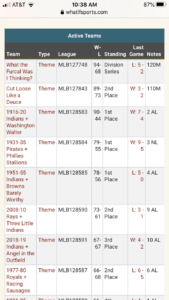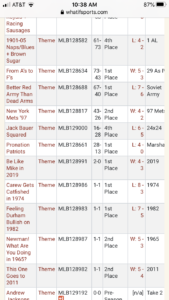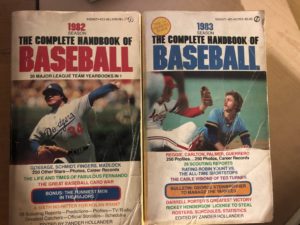A simulated baseball season played at 3 games per day takes about two months to complete, 54 days for the regular season, plus playoffs. So whether you’re having an outstanding season (as I celebrated in my post on a recent title) or a doomed one (as we are living through with the escapades of Jack Bauer Squared), I have a great deal of perspective on the flow of my various teams.
As of yesterday, the regular season for my six teams in the 2020 WIS Championship concluded, and I have only two of them advancing to the playoffs. Since I won’t be participating in Round 2 (a post mortem on that seems like a subject for a future post), it’s time to get excited about a new group of seasons starting.
A group of five entered in a mini-tournament began play last night, essentially replacing the teams I was managing in the WISC. Counting the two playoff teams remaining, I have 19 active teams for the moment. I check every box score three times a day and adjust lineups as needed. Some teams require constant shuffling, and others basically run themselves, but there is definitely a routine that I manage my day around.
Here’s what that looks like in phone screenshots after a round of games:


I have three more completed rosters waiting for leagues to fill, and all are likely to start within the next week. I’m signed up for a league that’s waiting to fill for its next draft. And inevitably my desire to build new rosters will kick in quickly and I’ll find another intriguing theme or two and enter more. The cycle keeps things endlessly fresh.
I have seven teams entered in Round 2 of a massive five-round tournament put on each year by thejuice6, who runs so many successful themes and tournaments he has his own forum for drafts. His leagues draw a great group of competitive owners and take you on deep dives into baseball history. Last year I made it to the final round and even within one round of the World Series, which is where the good prize money lives.
I entered seven teams in Round 1 this year and all advanced, and so far I’m on track to have six or seven move on to Round 3. When that round begins drafting, I’ll be able to detail the process behind my drafts and rosters. We are 133 games into Round 2, so that figures to kick in towards the end of the month.
One of my teams in the mini-tournament that just started is entirely made up of players from 1982. If you’ve read my previous post, you’ll appreciate why that was a special draft. I think it deserves a deeper dive soon, in fact, because it connects so many dots.
The journey here is not a straight line, so enjoy the digressions and tangents as they progress us in a distinctly non-linear fashion. I even have a great story to come about digressions! Maybe two!
